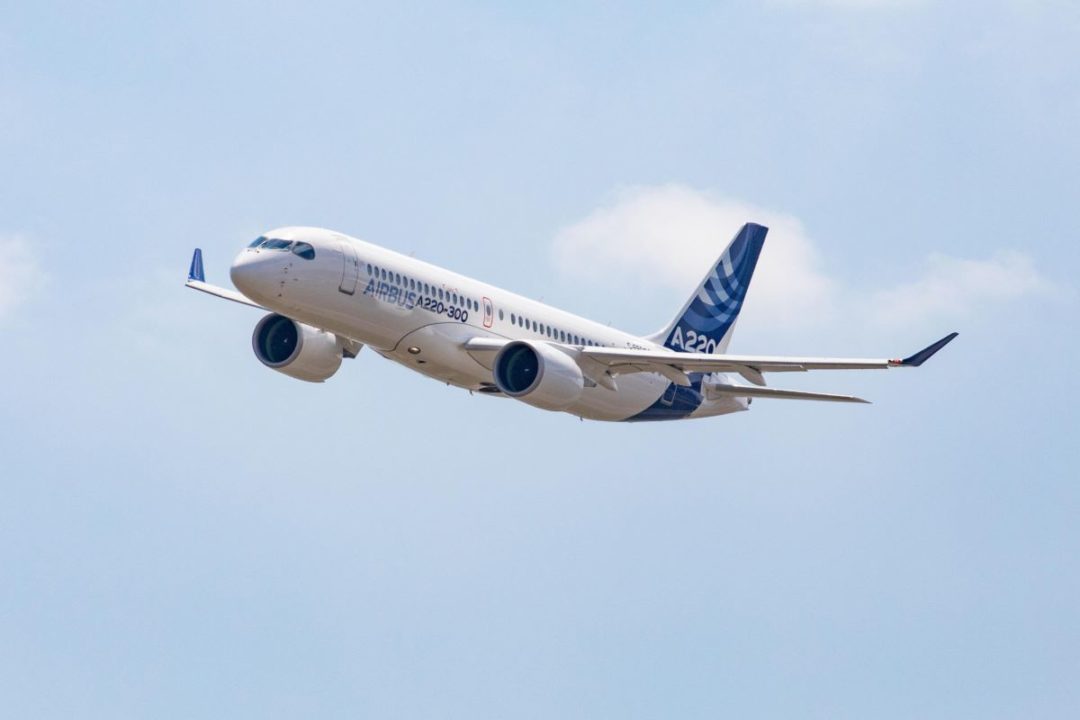
Home » Bombardier CEO Sees Blue Skies and Less Debt After Major Overhaul
Bombardier CEO Sees Blue Skies and Less Debt After Major Overhaul

Bombardier developed the C Series aircraft, but was unable to make it a financial success and had to offload it to Airbus, which renamed it the A220. Photo: Bloomberg
March 24, 2023
When Eric Martel returned to Bombardier Inc. in the spring of 2020, the company was hardly recognizable from the one he’d left five years earlier.
Bombardier had just sold its two biggest divisions, which built commercial jets and trains, in a desperate, sell-anything-you-can effort to raise money. A new viral disease called COVID-19 was ripping around the globe, forcing governments to lock down and throwing the economy into recession. Bombardier’s factories went silent.
“The company was in a very, very precarious situation,” Martel, 55, said during an interview in a lounge overlooking the firm’s jet finishing plant, near Montreal’s international airport.
Today, his task is no longer merely to keep the aerospace firm solvent. It’s to convince investors he has a credible plan for real growth, whatever happens in the economy. Bombardier announced more ambitious financial targets March 23, aiming for at least $9 billion in revenue and $900 million in free cash flow in 2025. That’s up from previous goals of $7.5 billion and $500 million, respectively.
The shares jumped as much as 9% in morning trading in Toronto. They’ve risen about sixfold since Martel took over as chief executive officer, a relief rally as the company made progress on paying down its towering debts. “We hit the bottom of the slope in 2020, and we are going back up,” he said.
Bombardier’s slide toward the brink of bankruptcy was triggered by its decision to challenge Boeing Co. and Airbus SE with the C Series commercial aircraft program. The project became a sinkhole: development costs went way over budget at $6 billion and the company was forced to offload it to Airbus, which renamed the jet the A220.
That was merely one stage in a years-long fire sale that also led Bombardier to announce the divestiture of its train-making division to France’s Alstom SA in early 2020. Soon after, Alain Bellemare departed as CEO.
It was up to Martel to finish the Alstom deal and two others and get the cash in the hangar. “There were three major transactions that were put into question in the context of COVID,” he said. “There were challenges, and we closed them all.”
But Martel, an electrical engineer by training, had one major advantage as he refocused the shrunken, demoralized firm around a much smaller business — selling private jets to the wealthy and corporations. He had run that business during his first stint with Bombardier. “My learning curve was fast.”
He ended production of the small cabin Learjet, betting instead on mid- and large-size private jets, the Challenger and the Global. In May, the Global 8000, an improved version of the Global 7500 that can carry as many as 19 people, was introduced in the market as the fastest business aircraft at an operating top speed of about 720 miles an hour and an $81 million price tag.
To increase revenue, the manufacturer has also reinvested in after-market service by expanding facilities, and now it’s looking to bolster its defense unit, which converts jets into military aircraft.
Goldman Sachs analyst Noah Poponak said Bombardier’s management team has done a “great job” improving operating performance, margins and cash flow. “I cover other private jet pure players that haven’t been as good, as strong and as clean as the results that have taken place here,” Poponak said.
The jet’s performance took rivals Gulfstream Aerospace Corp. and Dassault Aviation SA by surprise, according to Tehran Ebrahimi, a management professor and aerospace expert at the Université du Québec à Montréal. “Bombardier did not know the world of commercial aircraft like the C Series, which is why they had trouble convincing customers. But they know the world of business jets.”
Even the workers seem to have found their way after years of uncertainty. Bombardier once employed up to 60,000 people; now it has 15,900. When a strike threatened operations in Montreal last summer, Martel came down from his office to join the negotiations himself, according to Eric Rancourt, a representative with the aerospace workers’ union. A deal was sealed quickly. “Working relations had deteriorated with Bellemare because there was no communication,” explained Rancourt. “With Martel, we can talk to each other.”
All agree, though, that the future will not be easy. The pandemic accelerated the sale of private jets as wealthy people looked to continue traveling and sought more comfort and distance from others. That momentum has waned as COVID fears ease.
Goldman’s Poponak also warned that Bombardier isn’t immune to an economic downturn. “It is a cyclical business and somewhat a discretionary product,” he said, adding that the company still has a lot of debt.
Martel insists the firm is being cautious about its guidance, but remains confident about stronger demand from Asia since China’s reopening. Charter operators like NetJets and Flexjet used to account for 40% of the order book; now it’s 20%, with individuals and companies at 80%.
As the company stabilizes, it needs to continue to spend on innovation to keep up with its bigger rivals.
“Gulfstream is a phenomenal airplane company that makes incredible jets that the market loves,” said Poponak.
Martel told investors March 23 there are no plans for a new aircraft by 2025 that could cost billions to develop, but did not exclude mergers and acquisitions. “I feel no pressure from either the customer base or competitor to launch a program now,” he said.
Still, every aircraft manufacturer needs to have an answer to what it’s doing about climate change. Private jets have a high carbon footprint. At Bombardier, a futuristic-looking aircraft, nearly 20 feet long, is currently flying in a secret location to test various technologies. The EcoJet research project aims to optimize the aerodynamics, reducing emissions by 20% with existing engines.
Martel won’t talk in detail about a new plane, but says it’s making progress. “We even started looking at what the interior cabin might look like.”
RELATED CONTENT
RELATED VIDEOS
Subscribe to our Daily Newsletter!
Timely, incisive articles delivered directly to your inbox.
Popular Stories

2024 Supply Chain Management Resource Guide: There's Only One Way Off a Burning Platform
VIEW THE LATEST ISSUECase Studies
-
Recycled Tagging Fasteners: Small Changes Make a Big Impact
-

Enhancing High-Value Electronics Shipment Security with Tive's Real-Time Tracking
-

Moving Robots Site-to-Site
-
JLL Finds Perfect Warehouse Location, Leading to $15M Grant for Startup
-
Robots Speed Fulfillment to Help Apparel Company Scale for Growth



